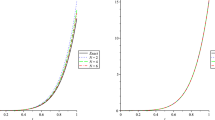Summary
Fractional calculus is used to describe the general behavior of materials with memory. An expression for the fractional derivative or the fractional integral is developed in terms of the Stieltjes convolution and the Riesz distribution. The general fractional calculus polynomial operator constitutive equation is reduced to a Stieltjes convolution. A constitutive equation which depends on a memory parameter for an isotorpic viscoelastic material is presented. The proposed creep compliance has an initial response, a primary creep region, a secondary creep region and a tertiary creep region. The corresponding relaxation modulus has a glassy region, a leathery region, a rubbery region and a liquid region.
Similar content being viewed by others
References
Gemant, A.: Compressional waves in media with complex viscosity. Physics6, 383–365 (1935).
Gemant, A.: The conception of a complex viscosity and its application to dielectrics. Trans Faraday Soc.31, 1582–1590 (1935).
Gemant, A.: A method of analyzing experimental results obtained from elasto-viscous bodies. Physics7, 311–317 (1936).
Gemant, A.: On fractional differentials. Philosophical Maganize25, 540–549 (1938).
Gamant, A.: Frictional Phenomena. Brooklyn, NY: Chemical Publishing Co. 1950.
Scott Blair, G. M., Coppen, F. M. V.: The subjective judgment of the elastic and plastic properties of soft bodies; the differential thresholds for viscosities and compression moduli. Roy. Soc.128B, 109–125 (1939).
Scott Blair, G. W., Coppen, F. M. V.: The classification of the rheological properties of industrial materials in the light of power-law relations between stress, strain, and time. J. Sci. Instr.19, 88–93 (1942).
Scott Blair, G. W.: A survey of general and applied rheology. New York: Pitman Publishing Corporation 1944.
Scott Blair, G. W., Veinolou, B. C., Caffyn, J. E.: Limitations of the Newtonian scale in relation to non-equilibrium rheological states and a theory of quasi-properties. Proc. Roy. Soc.189A, 69–87 (1947).
Scott Blair, G. W., Reiner, M.: The rheological law underlying the Nutting equation. Appl. Sci. Res.A 2, 225–234 (1950).
Nutting, P. G.: A new general law of deformation. Journal of the Franklin Institute191, 679–685 (1921).
Nutting, P. G.: A study of elastic viscous deformation. Proc. Amer. Soc. Test. Mater.21, 1162–1171 (1921).
Nutting, P. G.: A general stress-strain-time formula. J. Franklin Inst.235, 513–524 (1943).
Nutting, P. B.: Deformation in relation to time, pressure and temperature. J. Franklin Inst.242, 449–458 (1946).
Norton, F. H.: The creep of steel at high temperature, pp. 58–62. New York: McGraw-Hill 1929.
Ross, B.: A brief history and exposition of the fundamental theory of fractional calculus. Lecture Notes in Mathematics457, pp. 1–36 Springer 1975.
Oldham, K. B., Spanier, J.: The fractional calculus, Academic Press 1974.
Lacroix, S. F.: Traité du calcul différentiel et du calcul intégral, Tome Troisième, seconde edition, pp. 409–410. Paris: Mne. Ve Courcier 1819.
Koeller, R. C.: Application of fractional calculus to the theory of viscoelasticity, ASME Journal of Appl. Mechanics.51, 299–307 (1984).
Courant, R.: Differential and intergral calculus, Vol. II, p. 339. Blackie and Son Limited 1962.
Whittaker, Watson: A conurse in modern analysis, 4th Ed, p. 76. Cambridge Univ. Press 1927.
Gel'fand, I. M., Shilov, G. E.: Generalized functions; Volume 1, properties and operations. Academic Press 1964.
Riesz, F., Sz.-Nagy, B.: Functional analysis, p. 110. Frederick Ungar Publishing Co. 1944.
Bagley, R. L., Torvik, P. J.: A generalized derivative model for an elastomer damper. Shock Vibr. Bull., No. 49, Part 2, pp. 135–143, Sept. 1979.
Bagley, R. L., Torvik, P. J.: A theoretical basis for the application of fractional calculus to viscoelasticity. J. of Rheology27 (3), 201–210 (1983).
Bagley, R. L., Torvik, P. J.: Fractional calculus — A different approach to the analysis of viscoelastically damped structures. AIAA Journal21, 741–748 (1983).
Torvik, P. J., Bagley, R. L.: On the appearance of the fractional derivative in the behavior of real material. ASME J. Appl. Mech.51, 2940298 (1984).
Bagley, R. L., Torvik, P. J.: Fractional calculus in the transient analysis of viscoelastically damped structure. AIAA Journal23 (1985).
Gurtin, M. E., Sternberg, E.: On the linear theory of viscoelasticity. Arch. Ration. Mech. and Anal.11, 291–356 (1962).
Güttinger, W.: Generalized functions and dispersion relations in physics. Fortschritte der Physik14, 483–602 (1966).
Caputo, M.: Linear models of dissipation whoseQ is almost frequency independent. Ann. Geofisica19, 4, 383–393, 1966.
Caputo, M.: Linear models of dissipation whoseQ is almost frequency independent-II. Geophys. J. R. Astr. Soc.13, 529–539 (1967).
Caputo, M., Mainarrdi, F.: A new dissipation model based on memory mechanism. Pure Appl. Geophys.91, 134–147 (1971).
Caputo, M.: Vibration of an infinite viscoelastic layer with a dissipative memory. J. Acoust. Soc. Am.56 (3), 897–904 (1974).
Caputo, M.: Vibrations of an infinite plate with a frequency independentQ: J. Acoust. Soc. V.60 (3), 634–639 (1976).
Tobolsky, A. V., Catsiff, E.: Elastoviscous properties of polyisobutylene (and other amorphous polymers) from stress-relaxation studies. IX, a summary of results. Journal of Polymer Science19, 111–121 (1956).
Author information
Authors and Affiliations
Rights and permissions
About this article
Cite this article
Koeller, R.C. Polynomial operators, stieltjes convolution, and fractional calculus in hereditary mechanics. Acta Mechanica 58, 251–264 (1986). https://doi.org/10.1007/BF01176603
Received:
Issue Date:
DOI: https://doi.org/10.1007/BF01176603




